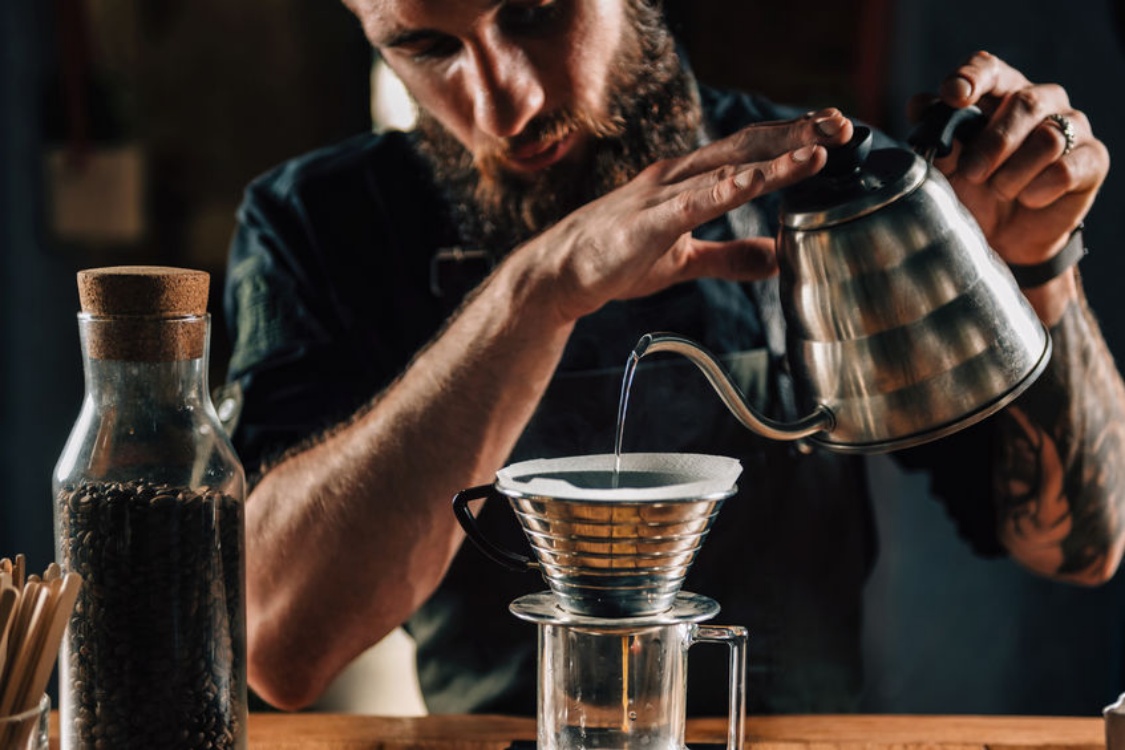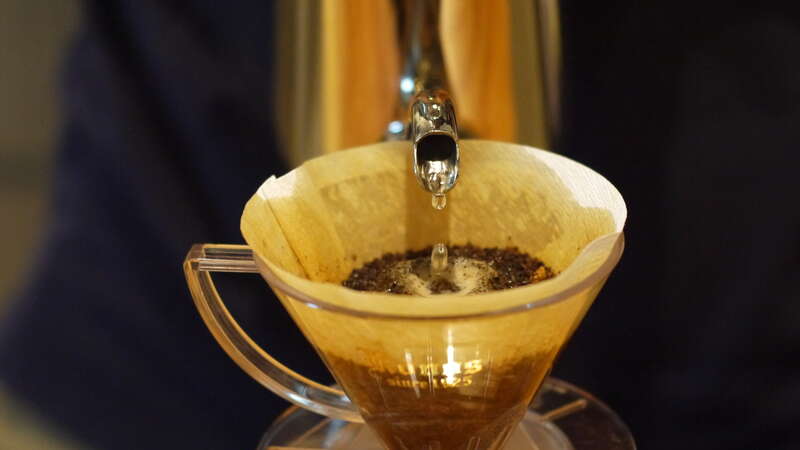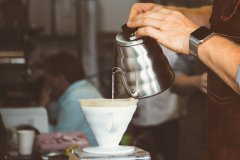Choose a good filter cup to make good coffee! How to choose a coffee filter cup?
Professional coffee knowledge exchange more coffee bean information please follow the coffee workshop (Wechat official account cafe_style)
When you open the door and walk into a hand-brewed coffee shop, in addition to wanting to taste a good cup of coffee, you probably want to buy a brewing ceremony. It seems that only through this ceremony can we calmly enjoy this good cup of coffee.
Suppose we want to do it ourselves? Hand-brewed coffee is explained in a simple way, filling the filter cup with water to filter the coffee powder and get a cup of coffee liquid. But more in-depth discussion of hand-made details, but pay great attention to coffee knowledge!
The choice from filter cup to filter paper, the control of water temperature, the time of extraction, the control of arm muscle and the skill of cutting off water will affect the flavor and quality of a cup of coffee.

But don't worry! You have to start from the beginning before you become a master. Now let's learn how to choose a filter cup.
Hand punching has been developed for about a hundred years, the most common cone filter cup is the Hario V60 filter cup, while the ladder filter cup is probably the best known Sanyo filter cup and Kalita filter cup. Another recent major shape is the Wave filter cup using wavy flat-bottomed cake filter paper.
All kinds of hand filter cups on the market can be classified by three key points:
1. Material-(temperature factor)
two。 Rib column-(velocity factor)
3. Shape-(extraction method)
This article will sort out all kinds of filter cups on the market and briefly introduce how to choose the filter cup that best suits you.
Material-temperature factor
Most of the filter cups are made of plastic, transparent glass, ceramic, stainless steel and red copper. the material of the filter cup directly affects the temperature of hand punching.
First of all, in terms of thermal conductivity (W / m °K):
Red copper (401) > stainless steel (122.45) > ceramic (1.22) > glass (1.1) > plastic (< 1)
The higher the thermal conductivity, the more the material can take the heat away, so it is more necessary to warm the cup before hand flushing, otherwise the water temperature drops more obviously during cooking. From this point of view, plastic is a good choice.
The following are the advantages of each material finishing:
Plastic: no need to warm the cup, high precision
Metal: more durable and high temperature resistant
Ceramic: good heat preservation effect, high temperature resistance
Glass: good light transmittance to observe the flow of water
These advantages can be taken into consideration.

Rib column-velocity factor
The strip protruding design in the filter cup is called rib column (also known as rib, guide ditch). The rib column can keep the appropriate gap between the filter paper and the filter cup and provide the flow of water. If there is no rib column to make the filter paper and the filter cup close, it will reduce the flow speed. Therefore, the design of rib column can indirectly affect the extraction speed and have different flavor.
Rib column design can be roughly divided into four types:
Short ribbed column design:
Example: KONO filter cup
Features: take into account the functions of soaking and water diversion, enhance the flavor level of coffee
Spiral long ribbed column:
Example: Hario V60
Features: speed up the flow of water, like twisting towels to extract the coffee flavor, the coffee flavor is bright
Straight ribbed column:
Examples: Kalita bone porcelain filter cup, Blue bottle blue bottle filter cup
Features: the difference with kono is that the rib column extends to the top of the rib column to enhance the exhaust effect and reduce the extraction of back flavor.
Non-ribbed column:
Example: Kalita Wave series
Features: need to match the cake cup filter paper, in fact, the rib column is made on the filter paper, directly let the flow down smoothly, the disadvantage is the high cost of filter paper
Of course, there are many shapes of ribbed columns, which will not be introduced here. But generally speaking, there are three concepts that can be used to judge the speed of water flow:
Length of rib column: the longer the rib column, the faster the flow rate.
The protruding degree of rib column: the more convex, the faster the flow rate.
Number of rib columns: the more the flow rate, the faster the velocity.
Shape-extraction mode
The shape of the filter cup can be divided into three types: cone, trapezoid and flat bottom, and the shape can affect the extraction mode and flow rate.
Conical shape
The tapered filter cup usually has a fast flow rate, and the water will extract the coffee by flushing, and because of the fast flow rate, if the water injection technology is not good, the coffee powder is easy to concentrate in the middle, resulting in uneven extraction of coffee powder. therefore, water injection technology and building powder walls all play an important role.
The tapered filter cup will have a faster coffee flow rate because of the three-dimensional structure of the ribs and the tip of the coffee filter paper, so the brewing of the coffee does not need to change too much, just let the coffee roll moderately to get a good extraction.
Trapezoid
There are single hole and three hole design. The flow rate is relatively slow, inclined to immersion extraction, the number of pores will affect the flow rate, as a whole, it will be slower than the cone-shaped filter cup, and the taste will be thicker, but it is also easy to overextract and make the coffee bitter.
Some trapezoidal filter cups are supported by internal ribs to make the liquid flow more smoothly, and the holes at the bottom can make different trapezoidal filter cups have different soaking time, but the characteristics of soaking can be used to make the flavor more different.
Round flat bottom
Flat-bottomed structure, coffee powder can be evenly green, cooking flow rate is slow, but also more like immersion extraction, it is necessary to avoid excessive extraction.
The round, flat-bottomed cake filter cup is the best way to make coffee powder spread out in the filter cup, because the coffee liquid does not flow directly, but has a certain degree of stagnant water to make coffee powder do more soaking, and the fault tolerance rate in brewing is also greatly improved.
Last
Filter cups have their own characteristics, but only relative advantages, no absolute advantages. From the above three key points, I believe you have a better understanding of the filter cup. I hope you can choose the filter cup that suits you and brew a delicious cup of coffee at home at any time!
END
Important Notice :
前街咖啡 FrontStreet Coffee has moved to new addredd:
FrontStreet Coffee Address: 315,Donghua East Road,GuangZhou
Tel:020 38364473
- Prev

[introduction tips] Teaching of six commonly used hand-brewing coffee techniques (with brewing parameters)
Professional coffee knowledge exchange more coffee bean information Please pay attention to the coffee workshop (Wechat official account cafe_style) just got the coffee beans, whether do not know how to make coffee trouble? Or bought beans from the cafe, but how can not rush out of the store to drink the smell? Today, the editor will introduce six commonly used hand-made coffee techniques to solve the above problems for you at the same time
- Next

The key to making coffee by hand _ five factors for beginners to make coffee
Professional coffee knowledge exchange more coffee bean information please follow the coffee workshop (Wechat official account cafe_style) the key to making coffee by hand. There are many coffee shops on the street, some mainly focus on the interior environment or the decoration on the coffee, selling the overall atmosphere and style, but in addition to these decorations, fine coffee slowly rises by simple taste, people who taste the coffee itself.
Related
- Beginners will see the "Coffee pull flower" guide!
- What is the difference between ice blog purified milk and ordinary milk coffee?
- Why is the Philippines the largest producer of crops in Liberia?
- For coffee extraction, should the fine powder be retained?
- How does extracted espresso fill pressed powder? How much strength does it take to press the powder?
- How to make jasmine cold extract coffee? Is the jasmine + latte good?
- Will this little toy really make the coffee taste better? How does Lily Drip affect coffee extraction?
- Will the action of slapping the filter cup also affect coffee extraction?
- What's the difference between powder-to-water ratio and powder-to-liquid ratio?
- What is the Ethiopian local species? What does it have to do with Heirloom native species?

